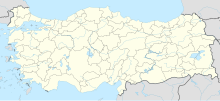Herakleia Pontike
Coordinates: 41 ° 17 ' N , 31 ° 25' E
Herakleia Pontike , in the Latin form of the name Heraclea Pontica (later Bender Ereğli , today Karadeniz Ereğli ), is an ancient city at the mouth of the Kilijsu (Gülüc River) in the Black Sea (Pontos Euxeinos) in what is now Turkey .
Herakleia Pontike was founded as a colony of Megaras around 560 BC. Founded in BC, it soon subjugated the native Mariandynians and expanded their power over a considerable territory. Originally the economy was predominantly agricultural, since the middle of the 5th century BC. The city was an important partner in the Black Sea trade; It experienced its economic heyday in the 4th century BC. Chr.
Initially, oligarchs ruled in Herakleia Pontike. Clearchus , who had belonged to the disciples of Plato and Isocrates in Athens , fell in 364/3 BC. The oligarchs, rose to be tyrants and became 352 BC. Murdered BC. He was followed by his underage son Timotheus, for whom Klearchus' brother Satyros until about 345 BC. The guardianship and government led. Dionysius , a younger brother of Timotheus, practiced from 338/7 BC. Alone the tyranny over Herakleia and appointed himself 306/5 BC. After the model of the Diadochs to the king. He was with a niece of the last Persian great king Dareios III. named Amastris , who took over the rule after the death of her husband (305 BC). At that time, a large stretch of coast belonged to the territory under Herakleia. Presumably Amastris was killed by her sons Klearchus and Oxathres, who were then executed on the orders of Lysimachus , a short-term ex-husband of the Amastris. Now Lysimachus seized in 284 BC. BC Herakleias and placed her under the rule of his wife Arsinoë II , who appointed a governor and ended the city's autonomy. After Lysimachus 281 BC. The Heracles drove out Arsinoes governor and regained their freedom. The city was in opposition to the Seleucid striving for power and therefore founded an alliance, the so-called Northern League. 188 BC Herakleia concluded a friendship and alliance treaty with Rome . When the great enemy of the Romans Mithridates VI. waged his third war against Rome, Herakleia entered 73 BC. On the side of the Pontic king and became part of his empire a year later . After two years of siege, the Roman general and former consul Marcus Aurelius Cotta took the city in 70 BC. And devastated it. Since 65/4 BC Herakleia belonged to the province of Pontus and was from 46/5 BC. BC Roman colonia . The triumvir Marcus Antonius assumed around 40 BC. The Greek part of the territory of Herakleia Adiatorix , a prince of the Galatians . 32/31 BC BC, shortly before the Battle of Actium , Adiatorix ordered the killing of the Roman colonists and was after the triumph of Augustus in 29 BC. Executed. Now the city was added to the province of Bithynia et Pontus and around 385 AD to the province of Honorias .
Nymphis of Herakleia wrote in the 3rd century BC A thirteen-volume history of the city, of which only fragments have survived. The historian Memnon of Herakleia also wrote an extensive history of the city in the 1st or 2nd century AD, using the work of Nymphis as a source. Excerpts from it are preserved in the Biblioteca des Photios .
Herakleia Pontike is the birthplace of Herakleides Pontikos .
In later times the place became famous for its mines, from which Constantinople got a large part of its fuel.
literature
- David Raoul Wilson: Herakleia (Ereğli) Pontus, Turkey . In: Richard Stillwell et al. a. (Ed.): The Princeton Encyclopedia of Classical Sites. Princeton University Press, Princeton NJ 1976, ISBN 0-691-03542-3 .
- Angela Bittner: Society and Economy in Herakleia Pontike. A polis between tyranny and self-government. (Asia Minor Studies Vol. 30). Habelt, Bonn 1998. ISBN 3-7749-2824-X
- Wolfram Hoepfner : Herakleia Pontike - Ereğli. An examination of the building history . (Tituli Asiae minoris supplementary volumes 1 = research on the north coast of Asia Minor, 2 = memoranda. Austrian Academy of Sciences, Philosophical-Historical Class. Vol. 89). Böhlau, Vienna 1966
- Lloyd Jonnes, Walter Ameling : The inscriptions of Heraclea Pontica. ( Inscriptions of Greek cities from Asia Minor, Vol. 47). Habelt, Bonn 1994. ISBN 3-7749-2647-6 .
- Sergei J. Saprykin: Heracleia Pontica and Tauric Chersonesus before Roman domination. VI – I centuries BC Hakkert, Amsterdam 1997. ISBN 90-256-1109-5
